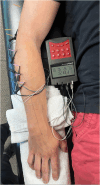Percutaneous tendon dry needling and thrust manipulation as an adjunct to multimodal physical therapy in patients with lateral elbow tendinopathy: A multicenter randomized clinical trial
- PMID: 38676324
- PMCID: PMC11348637
- DOI: 10.1177/02692155241249968
Percutaneous tendon dry needling and thrust manipulation as an adjunct to multimodal physical therapy in patients with lateral elbow tendinopathy: A multicenter randomized clinical trial
Abstract
Objective: The purpose of this study was to assess the effects of adding electrical dry needling and thrust manipulation into a multimodal program of exercise, mobilization, and ultrasound in patients with lateral elbow tendinopathy.
Design: Randomized, single-blinded, multicenter, parallel-group trial.
Setting: Thirteen outpatient physical therapy clinics in nine different US states.
Participants: One hundred and forty-three participants (n = 143) with lateral elbow tendinopathy were randomized.
Intervention: Cervical spine manipulation, extremity manipulation, and percutaneous tendon electrical dry needling plus multimodal physical therapy (n = 73) or multimodal physical therapy (n = 70) alone.
Main measures: The primary outcome was elbow pain intensity and disability as measured by the Patient-Rated Tennis Elbow Evaluation at baseline, 1 week, 4 weeks, and 3 months. Secondary outcomes included the Numeric Pain Rating Scale, Tennis Elbow Functional Scale, Global Rating of Change, and medication intake.
Results: The 2 × 4 analysis of covariance demonstrated that individuals with lateral elbow tendinopathy receiving electrical dry needling and thrust manipulation plus multimodal physical therapy experienced significantly greater improvements in disability (Patient-Rated Tennis Elbow Evaluation: F = 19.675; P < 0.001), elbow pain intensity (Numeric Pain Rating Scale: F = 22.769; P < 0.001), and function (Tennis Elbow Function Scale: F = 13.269; P < 0.001) than those receiving multimodal physical therapy alone at 3 months. The between-group effect size was large for pain and disability (Patient-Rated Tennis Elbow Evaluation: standardized mean difference = 1.13; 95% confidence interval: 0.78, 1.48) in favor of the electrical dry needling and thrust manipulation group.
Conclusions: The inclusion of percutaneous tendon electrical dry needling and thrust manipulation into a multimodal program of exercise, mobilization and ultrasound was more effective than multimodal physical therapy alone in individuals with lateral elbow tendinopathy.Trial Registration: www.clinicaltrials.gov NCT03167710 May 30, 2017.
Keywords: Lateral epicondylalgia; dry needling; elbow tendinopathy; exercise; manipulation; mobilization.
Conflict of interest statement
Declaration of Conflicting InterestsJ.D. is the Director of the American Academy of Manipulative Therapy Fellowship in Orthopaedic Manual Physical Therapy. The American Academy of Manipulative Therapy provides postgraduate training programs in musculoskeletal sonography, vestibular rehabilitation, spinal manipulation, spinal mobilization, dry needling, extremity manipulation, extremity mobilization, instrument-assisted soft-tissue mobilization, therapeutic exercise, and differential diagnosis to licensed physical therapists, dentists, osteopaths, and medical doctors. J.D., I.Y., P.B., P.G., and N.Z. are senior faculty of the American Academy of Manipulative Therapy Fellowship. None of the authors were directly involved with subject recruitment, treatment sessions, or data collection. None of the treating therapists were reimbursed in any way for subject recruitment, treatment sessions, or data collection. The other authors declare that they have no competing interests.
Figures





Similar articles
-
Spinal manipulation and perineural electrical dry needling in patients with cervicogenic headache: a multicenter randomized clinical trial.Spine J. 2021 Feb;21(2):284-295. doi: 10.1016/j.spinee.2020.10.008. Epub 2020 Oct 13. Spine J. 2021. PMID: 33065273 Clinical Trial.
-
Spinal manipulation and electrical dry needling as an adjunct to conventional physical therapy in patients with lumbar spinal stenosis: a multi-center randomized clinical trial.Spine J. 2024 Apr;24(4):590-600. doi: 10.1016/j.spinee.2023.12.002. Epub 2023 Dec 14. Spine J. 2024. PMID: 38103739 Clinical Trial.
-
Electrical dry needling as an adjunct to exercise, manual therapy and ultrasound for plantar fasciitis: A multi-center randomized clinical trial.PLoS One. 2018 Oct 31;13(10):e0205405. doi: 10.1371/journal.pone.0205405. eCollection 2018. PLoS One. 2018. PMID: 30379937 Free PMC article. Clinical Trial.
-
Effects of trigger point dry needling on lateral epicondylalgia of musculoskeletal origin: a systematic review and meta-analysis.Clin Rehabil. 2020 Nov;34(11):1327-1340. doi: 10.1177/0269215520937468. Epub 2020 Jun 23. Clin Rehabil. 2020. PMID: 32576044
-
Clinical effectiveness of shockwave therapy in lateral elbow tendinopathy: systematic review and meta-analysis.Clin Rehabil. 2021 Oct;35(10):1383-1398. doi: 10.1177/02692155211006860. Epub 2021 Apr 4. Clin Rehabil. 2021. PMID: 33813913
References
-
- Lucado AM, Day JM, Vincent JI, et al. Lateral elbow pain and muscle function impairments. J Orthop Sports Phys Ther 2022; 52: Cpg1–Cpg111. - PubMed
-
- Kraushaar BS, Nirschl RP. Current concepts review—tendinosis of the elbow (tennis elbow). Clinical features and findings of histological, immunohistochemical, and electron microscopy studies*. JBJS 1999; 81: 259–278. - PubMed
-
- Scott A, Backman LJ, Speed C. Tendinopathy: update on pathophysiology. J Orthop Sports Phys Ther 2015; 45: 833–841. - PubMed
Publication types
MeSH terms
Associated data
LinkOut - more resources
Full Text Sources
Medical

